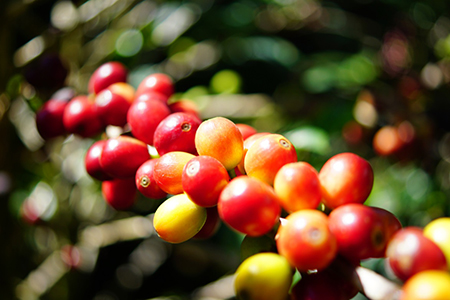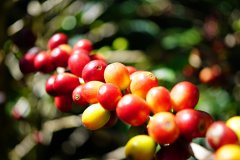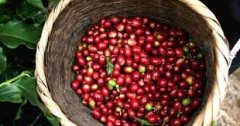Introduction to the principle of blending coffee beans to understand the blending of beans from three aspects
For professional baristas, please follow the coffee workshop (Wechat official account cafe_style)

In North America, most of the boutique coffee sold is in a single producing area, which is often called "Straight" coffee and sometimes mistakenly called "varietal". This may be because coffee comes from a single producing country, while coffee from an area in the producing country comes from a collection of multiple estates, a single estate, or a single variety grown in a specific block of an estate. In this way, the coffee will show the local characteristics of the growing area.
The taste spectrum of coffee in a single producing area can be changed by prolonging the storage time (aging), changing the roasting degree, or both. This fine-tuning gives coffee more changes without changing the concept of a single coffee producing area. Aging is to reduce acidity, increase alcohol thickness, and develop some unique details of flavor. Deepening baking has the same effect on the taste spectrum, reducing acidity and increasing thickness. But the flavor will be occupied by caramelized sugar.
There are about 80 coffee-producing countries in the world, each producing more or less different coffee. This may make people imagine that there is some kind of coffee somewhere that can satisfy all the taste buds. Unfortunately, that's not going to happen. However, there are still ways to overcome: bean matching skills, or the integration of different coffees to create tailor-made recipes, with clear flavor characteristics and richness to make people feel as attractive as a delicate single producing area.
The principle of matching beans:
One mix uses two or more coffees to create special flavors that are not found in any producing area. In some cases, formula beans have better flavor characteristics, while most recipes have higher flavor integrity and balance, and in some cases, recipes make the tonality of beans from a single producing area different.
My first time playing with beans was a year ago, just after I came into contact with the import and export business of coffee. To speed up my study of coffee, a friend in the same industry gave me a pound of Kenyan PB, which was rare in China at that time. Coffee is sour enough to beat Kenya AA, and its berry fruit tonality makes me think about it. But it is impossible to use more than 1 stroke 3 in a cup. So I cut the portion by half and replaced it with the low-acidity Indian coffee I had at the time, which showed a better sense of balance and made Kenya's flavor more tonality after reducing the acidity.
For a new coffee maker, this is a very exciting and satisfying bean matching experiment. But there are a lot of messy, or more commercial arguments that support the use of formula beans. The first reason the industry uses formula beans is that through the development of exclusive recipes, bakers can make market segments of their products, making it impossible for competitors to compete with the price and value of coffee. This is positive and the result of making good use of coffee knowledge, even if we do not reduce the quality of fine coffee as the premise, the purpose of bean blending is to highlight the characteristics of coffee rather than cover up defects. Another advantage is that through careful adjustment, we can compensate or correct the differences between each coffee harvest, each batch, and each bag, so as to prevent consumers from being affected by the vagaries of agricultural products.
The second reason for the commonly used formula beans in the industry is that they can control the cost, use commercial beans or cheap coffee, and adjust the proportion of these commercial beans in the formula, so that the baker can control the average cost of the product. but this practice usually ignores the quality or value given to consumers. Unfortunately, large commercial baking plants often use cheaper, rubber-flavored Robusta beans to increase profits and cast a shadow over the name formula beans.
The third reason for the commonly used formula beans in the industry is that they can take advantage of the reputation and popularity of specific coffee to deceive consumers and increase their value in a way, rather than providing real products. Kona and the Jamaican Blue Mountains are victims of this practice. Consumers often buy fake products or products with small origin names behind them, such as "flavor", "specialty", "formula" and so on. Consumers pay a very high value, but there is only a very small amount of Kona or Blue Mountain in the formula.
The formula of Espresso is different from that of filter coffee, because it is two different beverages. Filter coffee only extracts water-soluble ingredients from coffee, while Espresso also needs to extract oil from coffee to produce Crema. These extracted oils can obviously change the flavor characteristics and taste of Espresso. Filter coffee, regardless of the extraction method, can show a wider range of flavor levels in terms of acidity, richness, aroma, flavor, and tail rhyme. Espresso, on the other hand, is narrower in acidity, richness, color, Crema, aroma, flavor and finish. For example, the delicious acidity that needs to be found in filtered coffee is not easily accepted in Espresso because the way Espresso is made makes the acid in Espresso much stronger than that in filtered coffee with the same formula. So, a good Espresso formula will have a lower acidity.
Important Notice :
前街咖啡 FrontStreet Coffee has moved to new addredd:
FrontStreet Coffee Address: 315,Donghua East Road,GuangZhou
Tel:020 38364473
- Prev

Professional Evaluation of Disease-resistant varieties of Costa Rica Coffee Solar F1 Coffee Raw beans
For the exchange of professional baristas, please follow the coffee workshop (Wechat official account cafe_style) Costa Rica three Wonders Manor F1 sun Finca Tres Milagros F1 Natural for a long time, the improved varieties with good disease resistance in the boutique coffee circle have always had a bad impression, especially the first generation Hybrid such as Catimo. But in the recent COE competition, a lot of mixed varieties of manors
- Next

How to make coffee beans Espresso coffee blending formula and blending principle
For the exchange of professional baristas, please follow the coffee workshop (Wechat official account cafe_style) in North America, most of the boutique coffee sold is in a single producing area, which is often called Straight coffee, sometimes mistakenly called varietal. This may be due to the fact that coffee comes from a single producing country, while coffee from a certain producing area of the producing country comes from the collection of the
Related
- Detailed explanation of Jadeite planting Land in Panamanian Jadeite Manor introduction to the grading system of Jadeite competitive bidding, Red bid, Green bid and Rose Summer
- Story of Coffee planting in Brenka region of Costa Rica Stonehenge Manor anaerobic heavy honey treatment of flavor mouth
- What's on the barrel of Blue Mountain Coffee beans?
- Can American coffee also pull flowers? How to use hot American style to pull out a good-looking pattern?
- Can you make a cold extract with coffee beans? What is the right proportion for cold-extracted coffee formula?
- Indonesian PWN Gold Mandrine Coffee Origin Features Flavor How to Chong? Mandolin coffee is American.
- A brief introduction to the flavor characteristics of Brazilian yellow bourbon coffee beans
- What is the effect of different water quality on the flavor of cold-extracted coffee? What kind of water is best for brewing coffee?
- Why do you think of Rose Summer whenever you mention Panamanian coffee?
- Introduction to the characteristics of authentic blue mountain coffee bean producing areas? What is the CIB Coffee Authority in Jamaica?

